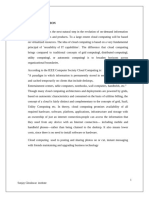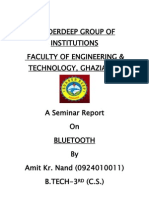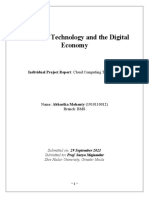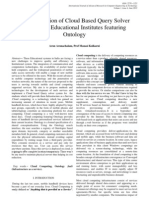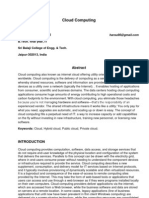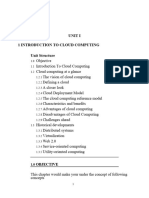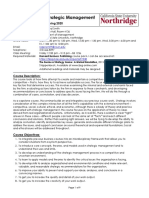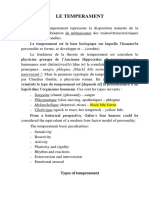According To The IEEE Computer Society Cloud Computing Is
According To The IEEE Computer Society Cloud Computing Is
Uploaded by
aaryavamanCopyright:
Available Formats
According To The IEEE Computer Society Cloud Computing Is
According To The IEEE Computer Society Cloud Computing Is
Uploaded by
aaryavamanOriginal Title
Copyright
Available Formats
Share this document
Did you find this document useful?
Is this content inappropriate?
Copyright:
Available Formats
According To The IEEE Computer Society Cloud Computing Is
According To The IEEE Computer Society Cloud Computing Is
Uploaded by
aaryavamanCopyright:
Available Formats
1.INTRODUCTION Cloud computing is the next natural step in the evolution of on-demand information technology services and products.
To a large extent cloud computing will be based on virtualized resources. The idea of cloud computing is based on a very fundamental principal of `reusability of IT capabilities`. The difference that cloud computing brings compared to traditional concepts of .grid computing., .distributed computing., .utility computing., or .autonomic computing. is to broaden horizons across organizational boundaries.
According to the IEEE Computer Society Cloud Computing is:
"A paradigm in which information is permanently stored in servers on the Internet and cached temporarily on clients that include desktops, entertainment centers, table computers, notebooks, wall computers, handhelds, etc."
Though many cloud computing architectures and deployments are powered by grids, based on autonomic characteristics and consumed on the basis of utilities billing, the concept of a cloud is fairly distinct and complementary to the concepts of grid, SaaS, Utility Computing etc. In theory, cloud computing promises availability of all required hardware, software, platform, applications, infrastructure and storage with an ownership of just an internet connection.
People can access the information that they need from any device with an Internet connection including mobile and handheld phonesrather than being chained to the desktop. It also means lower costs, since there is no need to install software or hardware..
Cloud computing used to posting and sharing photos on orkut, instant messaging with friends maintaining and upgrading business technology
2.Concepts
A powerful underlying and enabling concept is computing through service-oriented architectures (SOA) - delivery of an integrated and orchestrated suite of functions to an end-user through composition of both loosely and tightly coupled functions, or services - often network based. Related concepts are component-based system engineering, orchestration of different services through workflows, and virtualization.
2.a) Cyber infrastructure
Cyber infrastructure makes applications dramatically easier to develop and deploy, thus expanding the feasible scope of applications possible within budget and organizational constraints, and shifting the scientists and engineers effort away from information technology development and concentrating it on scientific and engineering research. Cyber infrastructure also increases efficiency, quality, and reliability by capturing commonalities among application needs, and facilitates the efficient sharing of equipment and services.
Today, almost any business or major activity uses, or relies in some form, on IT and IT services. These services need to be enabling and appliance-like, and there must be an economy of- scale for the total-cost-of-ownership to be better than it would be without cyber infrastructure. Technology needs to improve end-user productivity and reduce Technology-driven overhead
2.b). Service-Oriented Architecture
SOA is not a new concept, although it again has been receiving considerable attention in recent years [e.g., Bel08, IBM08a]. Examples of some of the first network-based service-oriented architectures are remote procedure calls (RPC), DCOM and Object Request Brokers (ORBs) based on the CORBA specifications . A more recent example are so called .Grid Computing. architectures and solutions . In an SOA environment end-users request an IT service (or an integrated collection of such services) at the desired functional, quality and capacity level, and receive the reponse at the time requested or at a specified later time. Service discovery, brokering, and reliability are important .Goal of the SOA is that creating an architecture in which servises are able to communicate using http protocol It is expected that in the next 10 years, service-based solutions will be a major vehicle for delivery of information and other IT assisted functions at both individual and organizational levels.
e.g., software applications, web-based services, personal and business .desktop. computing.
3.Cloud Architecture
Cloud architecture the systems architecture of the software systems involved in the delivery of cloud computing, comprises hardware and software designed by a cloud architect who typically works for a cloud integrator. It typically involves multiple cloud components communicating with each other over application programming interfaces, usually web services. Is closely resembles the Unix philosophy of having multiple programs doing one thing well and working together over universal interfaces. Complexity is controlled and the resulting
systems are more manageable than their monolithic counterparts.
Cloud architecture extends to the client, where web browsers and/or software applications access cloud applications. Cloud storage architecture is loosely coupled, where metadata operations are centralized enabling the data nodes to scale into the hundreds, each independently delivering data to applications or users 400px-CloudComputingSampleArchitecture
3.a) Cloud Types
Public cloud: Public cloud or external cloud describes cloud computing in the traditional mainstream. Public clouds are run by third parties, and applications from different customers are likely to be mixed together on the clouds servers, storage systems, and networks. A public cloud provides services to multiple customers.
Working Of Cloud Computing:
Cloud Computing system can be divided it into two sections: the front end and the back end. They connect to each other through a network, usually the Internet. Thefront end is the side the computer user, or client, sees.The back end is the "cloud" section of the system. On the back end there are various computers,servers and data storage systems that create the "cloud" of computing services.A central server administers the system, monitoring traffic and client demands to ensure everything runs smoothly. It follows a set of rules called protocols Servers and remote computers do most of the work and store the data.
Merits & Demerits:
Merits: Cloud enabler technologies like utility computing, Grid Computing, RTI, web infrastructure and others are cloud enabled.
1. Infrastructure service providers are taking advantage of the Cloud services. 2. Information services, entertainment-oriented services such as video on demand, simple business services such as customer authentication or identity management and contextual services such as location or mapping services are positioned well by using the service. 3. Other services, such as corporate processes (for example, billing, deduction management and mortgage calculation) and transactional services (for example, fiscal transactions), would take longer to reach the cloud and the mainstream.
4. Cloud computing infrastructures allows efficient use of their IT hardware and software investments 5. A cloud infrastructure can be a cost efficient model for delivering information services, reducing IT management complexity. 6. The Cloud makes it possible to launch Web 2.0 applications quickly and to scale up applications as much as needed when needed.
Demerits:
Stored data might not be secure: With cloud computing, all our data is stored on the cloud. The
unauthorized users gain access to our confidential data. Dependent on internet connection:Internet connectivity isnt completely stable and reliable. Its not platform agnostic:Most clouds force participants to rely on a single platform or host only one type of product. Can be slow:Even on a fast connection,web based application scan sometimes be slower than accessing a similar software program on our desktop PC
Conclusion
.Cloud. computing builds on decades of research in virtualization, distributed computing, utility computing, and more recently networking, web and software services. It implies a service oriented architecture, reduced information technology overhead for the end-user, great flexibility, reduced total cost of ownership, ondemand services and many other things. In today's global competitive market, companies must innovate and get the most from its resources to succeed. Cloud computing infrastructures are next generation platforms that can provide tremendous value to companies of any size. They can help companies achieve more efficient use of their IT hardware and software investments and provide a means to accelerate the adoption of innovations.Cloud computing increases profitability by improving resource utilization. Costs are driven down by delivering appropriate resources only for the time those resources are needed. Cloud computing has enabled teams and organizations to streamline lengthy procurement processes. Cloud computing enables innovation by alleviating the need of innovators to find resources to develop, test, and make their innovations available to the user community. Innovators are free to focus on the innovation rather than the logistics of finding and managing resources that enable the innovation.
You might also like
- Cloud Computing Research PaperDocument11 pagesCloud Computing Research PaperPracheta BansalNo ratings yet
- Paper Presentation-Cloud ComputingDocument14 pagesPaper Presentation-Cloud Computingdeepakfct100% (4)
- Listening IX (Question Paper)Document4 pagesListening IX (Question Paper)sinziclipcea100% (1)
- Sai INTRODUCTIONDocument21 pagesSai INTRODUCTIONmirajesaiNo ratings yet
- Sunderdeep Group of Institutions Faculty of Engineering & Technology, GhaziabadDocument16 pagesSunderdeep Group of Institutions Faculty of Engineering & Technology, Ghaziabadamitnand7No ratings yet
- Cloud Computing DraftDocument14 pagesCloud Computing Draftakhil829208No ratings yet
- Cloud Computing: Cloud Computing Is The Delivery of Computing As A Service Rather Than A Product, WherebyDocument15 pagesCloud Computing: Cloud Computing Is The Delivery of Computing As A Service Rather Than A Product, WherebyShashank GuptaNo ratings yet
- ReportDocument17 pagesReportsaurabh128No ratings yet
- Presentation On Cloud ComputingDocument21 pagesPresentation On Cloud ComputingPraveen Kumar PrajapatiNo ratings yet
- Cloud ComputingDocument4 pagesCloud Computingsankit120kNo ratings yet
- Seminar ReportDocument17 pagesSeminar Reportshinchan noharaNo ratings yet
- Seminar ReportDocument17 pagesSeminar Reportshinchan noharaNo ratings yet
- Module1 IntroductionDocument42 pagesModule1 Introductionpuneetkumbar402No ratings yet
- Cloud ComputingDocument11 pagesCloud ComputingMd MinhajNo ratings yet
- Seminar ReportDocument17 pagesSeminar ReportJp Sahoo0% (1)
- Report Cloud ComputingDocument15 pagesReport Cloud ComputingsaneshsivanNo ratings yet
- New Microsoft Word DocumentDocument12 pagesNew Microsoft Word DocumentKumar Raja0% (1)
- What Is Cloud ComputingDocument22 pagesWhat Is Cloud Computingmahakkumari481No ratings yet
- Cloud Computing: Presentation ByDocument20 pagesCloud Computing: Presentation Bymahesh_mallidiNo ratings yet
- Cloud Computing: Ahmed Ibrahem Muhammed Biomedical Informatics Diploma 2011/2012Document8 pagesCloud Computing: Ahmed Ibrahem Muhammed Biomedical Informatics Diploma 2011/2012aibrahemmNo ratings yet
- ETI Micro Project Cloud ComputingDocument6 pagesETI Micro Project Cloud ComputingSheshrao LandgeNo ratings yet
- Iec College of Engineering & Technology, Gr. Noida: Cloud ComputingDocument21 pagesIec College of Engineering & Technology, Gr. Noida: Cloud ComputingTushar AgarwalNo ratings yet
- Ijett V21P256Document8 pagesIjett V21P256Bharath KumarNo ratings yet
- Unit I-Cloud ComputingDocument29 pagesUnit I-Cloud ComputingAR OFFICIALNo ratings yet
- My Seminar Report On Cloud ComputingDocument18 pagesMy Seminar Report On Cloud ComputingKevin NettarNo ratings yet
- Privacy Preserving Intermediate Datasets in The CloudDocument83 pagesPrivacy Preserving Intermediate Datasets in The CloudSuganya PeriasamyNo ratings yet
- Abstract-: Keywords: Applications, Architecture, Business Component of CloudDocument15 pagesAbstract-: Keywords: Applications, Architecture, Business Component of CloudKrishna BoreddyNo ratings yet
- Fiot Unit 5Document27 pagesFiot Unit 5AbhijithNo ratings yet
- A Study of Cloud Computing MethodologyDocument5 pagesA Study of Cloud Computing MethodologyR Dharshini SreeNo ratings yet
- The Privacy Implications of Cloud Computing in The Context of Software Reverse EngineeringDocument7 pagesThe Privacy Implications of Cloud Computing in The Context of Software Reverse EngineeringJournal of Computer Science and EngineeringNo ratings yet
- DOM205 - Individual Project - Cloud Computing ABHARIKA MOHANTYDocument18 pagesDOM205 - Individual Project - Cloud Computing ABHARIKA MOHANTYAbharika MohantyNo ratings yet
- CC DocumentDocument13 pagesCC Documentgopikrishnan1234No ratings yet
- Cloud Computing: Age of InternetDocument6 pagesCloud Computing: Age of InternetAlmore Cato IINo ratings yet
- Implementation of Cloud Based Query Solver System For Educational Institutes Featuring OntologyDocument7 pagesImplementation of Cloud Based Query Solver System For Educational Institutes Featuring OntologyIjarcet JournalNo ratings yet
- "Cloud Computing": Made By: Aayush Chopra 09itmg1001cseDocument23 pages"Cloud Computing": Made By: Aayush Chopra 09itmg1001cseAbhimanyu NarwalNo ratings yet
- A Paper On Cloud Computing Ref JagadishDocument9 pagesA Paper On Cloud Computing Ref Jagadishparamesh0098No ratings yet
- Harshvardhan Saini: Cloud ComputingDocument5 pagesHarshvardhan Saini: Cloud ComputingHarshvardhan SainiNo ratings yet
- Cloud Computing: Cloud Computing Is A Technology That Uses The Internet and Central Remote Servers To Maintain Data andDocument11 pagesCloud Computing: Cloud Computing Is A Technology That Uses The Internet and Central Remote Servers To Maintain Data androhan7801No ratings yet
- Seminar Report On Cloud Computing.Document25 pagesSeminar Report On Cloud Computing.Rahul Kumar Singh100% (1)
- Cloud ComputingDocument10 pagesCloud ComputingTameta DadaNo ratings yet
- Cloud Computin 1Document14 pagesCloud Computin 1Srinath KrishnanNo ratings yet
- Chapter 2 Literature ReviewDocument21 pagesChapter 2 Literature ReviewNazaf AzmiNo ratings yet
- Cloud ComputingDocument3 pagesCloud ComputingNandan KumarNo ratings yet
- Fog ComputingDocument31 pagesFog ComputingPranjali100% (2)
- Data Center Cloud WPDocument12 pagesData Center Cloud WPaajayhsharmaNo ratings yet
- Cloud Computer SlidesDocument160 pagesCloud Computer SlidesKhuram ShahzadNo ratings yet
- Cloud ComputingDocument82 pagesCloud ComputingKartheeswari SaravananNo ratings yet
- Unit 1Document13 pagesUnit 1Bnod MsraNo ratings yet
- Iot R16 - Unit-5Document23 pagesIot R16 - Unit-5Surendra KumarNo ratings yet
- Cloud ComputingDocument5 pagesCloud ComputingkevmatinNo ratings yet
- Fiot V Unit R18 UwDocument45 pagesFiot V Unit R18 UwHARSHINI RAVVANo ratings yet
- Compiled Note On Cloud Computing - 2Document44 pagesCompiled Note On Cloud Computing - 2Suresh SinghNo ratings yet
- "Business Models in Cloud Computing": Assignment-1Document22 pages"Business Models in Cloud Computing": Assignment-1Ajay KakkarNo ratings yet
- Cloud Computing: Ii HistoryDocument3 pagesCloud Computing: Ii HistoryDarshnik Deep100% (1)
- Survey On Security Issues in Cloud ComputingDocument20 pagesSurvey On Security Issues in Cloud ComputingRishi KumarNo ratings yet
- Intel's Vision of The Ongoing Shift To Cloud ComputingDocument4 pagesIntel's Vision of The Ongoing Shift To Cloud Computingshekhar785424No ratings yet
- CC Unit 1Document150 pagesCC Unit 1rparth152No ratings yet
- Note 2Document132 pagesNote 2BishalNo ratings yet
- CC Unit IDocument31 pagesCC Unit ISuriyaNo ratings yet
- Cloud Computing Made Simple: Navigating the Cloud: A Practical Guide to Cloud ComputingFrom EverandCloud Computing Made Simple: Navigating the Cloud: A Practical Guide to Cloud ComputingNo ratings yet
- Cloud Computing and Virtualization: Streamlining Your IT InfrastructureFrom EverandCloud Computing and Virtualization: Streamlining Your IT InfrastructureNo ratings yet
- List of Accredited Unesco Club January 2013Document2 pagesList of Accredited Unesco Club January 2013api-196568751No ratings yet
- PDF Experience Psychology 2nd Edition King Test Bank downloadDocument41 pagesPDF Experience Psychology 2nd Edition King Test Bank downloadhermetnokwahNo ratings yet
- Tio ResearchDocument10 pagesTio ResearchTiolly PeñaflorNo ratings yet
- Study: Method For Information Management: Useful ResearchDocument11 pagesStudy: Method For Information Management: Useful ResearchMichellgutierrez7833No ratings yet
- CISCEDocument1 pageCISCEjemuel.vedhNo ratings yet
- Self ManagementDocument78 pagesSelf ManagementvianlimNo ratings yet
- Marcus Highschool Percussion EnsembleDocument1 pageMarcus Highschool Percussion Ensemble74xk4qqcc9No ratings yet
- Java IntroDocument345 pagesJava IntroAnurag291No ratings yet
- Jaep36241 246Document7 pagesJaep36241 246Julie DelreyNo ratings yet
- CSUN - BUS 497A-25 Spring 2020 - SyllabusDocument9 pagesCSUN - BUS 497A-25 Spring 2020 - SyllabusJulioNo ratings yet
- Activity 1 Cell Theory Timeline 2022Document3 pagesActivity 1 Cell Theory Timeline 2022insert generic username hereNo ratings yet
- Multiple Intelligences - Learning MapDocument2 pagesMultiple Intelligences - Learning Mapapi-322059527No ratings yet
- White and Blue Clean Lines Sales Executive ResumeDocument2 pagesWhite and Blue Clean Lines Sales Executive Resumekurnia031192No ratings yet
- Live Project FormatDocument14 pagesLive Project FormatUttamKumarNo ratings yet
- Chondrosarcoma: Moderator:Director & HOD PROF - DR.K.PRAKASAM M.S.Ortho, D.Ortho, DSC (HON)Document30 pagesChondrosarcoma: Moderator:Director & HOD PROF - DR.K.PRAKASAM M.S.Ortho, D.Ortho, DSC (HON)IceBearNo ratings yet
- ParentingDocument29 pagesParentingaufdecken 5No ratings yet
- Chapter I IntroductionDocument12 pagesChapter I IntroductionSiti Zaenab AhmadNo ratings yet
- SENIOR HIGH SCHOOL-Practical Research 1: A. Most Essential Learning Competency (MELC)Document6 pagesSENIOR HIGH SCHOOL-Practical Research 1: A. Most Essential Learning Competency (MELC)JOHN REALDANo ratings yet
- Impact UnitwalkthroughDocument15 pagesImpact UnitwalkthroughMARIA JULIANA CHAVEZ CHAPARRONo ratings yet
- Vender ListDocument218 pagesVender ListRaju KumarNo ratings yet
- 3a PPT Adolescence 9 18 Years Emotional DevelopmentDocument30 pages3a PPT Adolescence 9 18 Years Emotional DevelopmentKen MelendezNo ratings yet
- TemperamentDocument2 pagesTemperamentHellena MaNo ratings yet
- Cars (Pumarada)Document10 pagesCars (Pumarada)RocelynNo ratings yet
- Godfrey Harold Hardy Contribution MathematicsDocument3 pagesGodfrey Harold Hardy Contribution MathematicsRich0% (1)
- Lesson 1 - Level 1 Interactive WorksheetDocument3 pagesLesson 1 - Level 1 Interactive WorksheetСтефанія ТимківNo ratings yet
- Colour TheoryDocument18 pagesColour TheoryMoni AksdalNo ratings yet
- Shri - Shiv Khera Speaks On Why Winners Stand Alone - Principles of Business Success - Workshop Held On 1-11-2013 at KochiDocument6 pagesShri - Shiv Khera Speaks On Why Winners Stand Alone - Principles of Business Success - Workshop Held On 1-11-2013 at KochiArc AngleNo ratings yet
- KAP Questionnaire For Health WorkersDocument3 pagesKAP Questionnaire For Health WorkersDharma Reddy PashapuNo ratings yet
- 52042-MariaPaulaMARTINEZ HERRERA-BSBRES411-CoverSheet-RESUBMISSION PDFDocument2 pages52042-MariaPaulaMARTINEZ HERRERA-BSBRES411-CoverSheet-RESUBMISSION PDFPaula MartinezNo ratings yet



